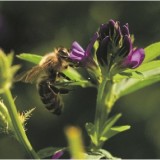When the final tally is done on humanity’s many post-Industrial Revolution screw ups, it is likely that the top of the list will be: They let the bees die.
Consider this: According to a 2010 UN Environmental Programme report, some 100 crop species provide 90% of food worldwide. Nearly three quarters of these crops depend for their existence on pollination by bees.
This process, which has succeeded for millennia, is now under serious threat.
Every winter since 2006 when the term colony collapse disorder (CCD) was coined, commercial bee keepers in Canada have been losing an average of 30% of their bees. (Last winter, south and central Vancouver Island bee keepers lost 80% of their colonies.) To stay in business they are now importing bees from New Zealand.
There is as yet no definitive scientific explanation for why the bees are dying – or simply disappearing – but there is a great body of evidence to suggest the culprit is a family of insecticides called neonicotinoids, which are now widely used in agriculture worldwide.
It’s been known since these chemicals came onto the market in 1995 that they were extremely toxic to bees. Tragically, as with so many of the highly toxic chemicals regulators have allowed to be chucked into our environment since the 1950s, it was only after the fact that independent scientific research began indicating quite how bad the problem is.
Long story short: It now seems likely that exposing bees to this family of insecticides compromises their immune systems and is roughly the equivalent of deliberately giving them AIDS.
How did Canada’s Pest Management Regulatory Agency (PMRA) and other regulatory agencies around the world allow this to happen?
Simple: The primary information considered by the PMRA is provided by the manufacturers who make millions of dollars from their patented chemical compounds. As if this process wasn’t suspect enough, even when the studies provided are deemed insufficient, PMRA may provide temporary or conditional registrations.
Research by Anne Sherrod of the Valhalla Wilderness Society reveals that increasing commercial use of products based on imidacloprid (a particularly worrying neonicotinoid) has been based, since 2001, on registrations deemed “temporary pending further studies”.
According to the PMRA, imidacloprid has been actively under re-evaluation since 2009. However, Access to Information Act requests to the agency have produced no evidence to support this claim. Meanwhile, imidacloprid and other neonicotinoid products continue to be widely used on vegetables, fruit, nuts and grain.
The PMRA points out that these lethal products must come with labels warning farmers not to apply the insecticide when plants are in flower or bees are nearby. This vacuous mitigation ignores the fact that these systemic insecticides are absorbed into every part of the plant, including the pollen and nectar. Despite their well-documented threat to bees, the PMRA justifies approving these products because of their “value” to human food production.
In the U.S. more than a million people have signed a petition demanding a neonicotinoid insecticide ban. Similar action is being demanded in New Zealand.
Canada needs to catch up. Yes, we can all email our MPs, demanding immediate action to protect bees. We can also voice our concerns about the threats to bees posed by the PMRA to Health Minister Leona Aglukkaq.
And while we’re waiting for the politicians, we can each do our bit by thinking about bees when we are planting our gardens. Even apartment window boxes can help. (Helpful hint for those of us who need to be bee-friendly and deer-proof when we plant: Catmint, coneflower, foxglove, sunflower, lavender, sage, thyme and yarrow all fit the bill.)
These little yellow and black creatures are perhaps nature’s greatest gift to humanity and yet we’re allowing corporate greed and what amounts to regulatory malfeasance to threaten them with extinction. Seriously, are we out of our minds?
Miranda Holmes is an associate editor of Watershed Sentinel magazine. For more information on this topic, go to www.watershedsentinel.ca/content/disappearance-bees-and-pesticide-link.


We also “know” that EMR is also a very likely “cause” of the loss of bees. It is becoming quite apparent that not only is Global Warming a serious threat but so is the unnecessary use of cellular technology. Read this article,
http://emrstop.org/index.php?option=com_content&view=article&id=145:a-towering-problem-for-birds-and-bees&catid=6:emfemr-information&Itemid=36
then do an internet search. And make sure you watch the film “Full Signal”.
It is very depressing to think that I may actually live long enough (to 2050) to witness the Earth’s demise thanks to human apathy and indifference.
Greg Shea (Lake Cowichan)
An action opportunity at http://www.avaaz.org/en/bayer_save_the_bees/?cl=1772962228&v=13920
More damning evidence: http://www.hsph.harvard.edu/news/press-releases/2012-releases/colony-collapse-disorder-pesticide.html
I think the problem with science in general ,is most of it is exactly what someones boss wants everyone to believe,NOT REALY WHAT HAS BEEN DISCOVERD…take a close look at the fishfarm issue,then decide if you think the science in Canada is B.S. or not….PEOPLE STOP LISTENING AFTER A WHILE
Great article. Why hasn’t this issue gotten more press?